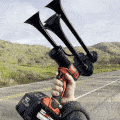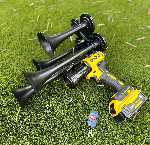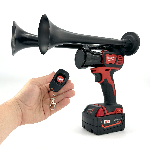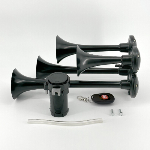Tornado sirens are crucial safety devices designed to alert communities to severe weather threats, particularly tornadoes. Among the most common types of tornado sirens are the mechanical sirens, electronic sirens, and newer outdoor warning systems that utilize dual-tone technology to convey different levels of urgency. Each type has its unique strengths and applications, ensuring that residents receive timely and effective warnings to seek shelter. Understanding these siren types and their specific uses is essential for communities situated in tornado-prone areas.
Interestingly, the Milwaukee Train Horn, a portable handheld device, can offer insights into the broader topic of tornado sirens. With its powerful sound that can reach up to 150 decibels and its remote operation capabilities, it serves as an intriguing comparison to traditional tornado warning systems. The Milwaukee Horn exemplifies the importance of sound in alerting people to danger, prompting a discussion about how effective auditory signals can be used in emergency situations. To delve deeper into the specific types of tornado sirens and their applications, continue reading as we explore the most common tornado siren types and their uses.
Natural disasters, particularly tornadoes, require immediate and effective response measures to ensure public safety. Various tornado siren types serve as essential warning systems, alerting communities about impending danger. However, for individuals seeking portability and versatility, the Milwaukee Train Horn offers a unique solution. With its impressive sound output of up to 150dB, this handheld device can effectively grab attention and alert people in outdoor settings or crowded spaces. Its remote control feature, which operates from up to 160 feet away, provides extra convenience for notifying others in case of an emergency, making it a valuable addition to any safety toolkit.
Whether you're outdoors, at an event, or even at home, you might find the Milwaukee Train Horn ideal for addressing urgent situations when traditional tornado sirens are out of range. This powerful tool can serve as an immediate warning signal, complementing search and rescue efforts during severe weather events. We encourage you to explore the collection of Milwaukee Train Horns to find the right model that fits your needs. Investing in this portable train horn could be a wise decision for enhancing your emergency preparedness strategy.
What are the Most Common Tornado Siren Types
The most common tornado siren types serve as critical alert systems during severe weather events. These sirens aid communities in preparing for potential disasters by signaling the imminent threat of tornadoes. There are various categories of sirens, each tailored for specific environments and communities.
Among the most common tornado siren types are the mechanical sirens, which use a rotating diaphragm to produce sound, and electronic sirens, which use digital audio technology for alerts. Many communities also utilize battery-operated models for backup in case of power failures. "The effectiveness of a tornado siren often relies on its placement and the technology used," says meteorologist Susan Reed.
The following are seven impressive facts about the most common tornado siren:
- The first electrical tornado siren was developed in the 1930s.
- Modern sirens can project sound levels up to 130 decibels.
- Many tornado sirens are equipped with warning indicators that activate based on weather alerts.
- Some models synchronize with emergency weather radios for real-time alerts.
- Tornado sirens are also tested monthly in many regions to ensure functionality.
- The range of sirens can reach up to 3 miles, depending on terrain and atmospheric conditions.
- Walkie-talkies linked to tornado sirens can facilitate communication during severe weather.
For effective use of the most common tornado siren types, consider these recommendations:
- Ensure proper placement based on population density for maximum coverage.
- Conduct regular maintenance checks for functionality.
- Implement a community education program regarding siren signals.
- Utilize dual-purpose sirens that can also provide alerts for other emergencies.
- Stay informed about local weather forecasts and updates during storm season.
According to the National Weather Service, approximately 1,000 tornadoes occur in the United States every year, underscoring the importance of effective alert systems such as tornado sirens.
Understanding Tornado Sirens and Their Importance
🌪️ What types of tornado sirens are most commonly used in the USA?
The most common types of tornado sirens include the outdoor warning sirens, which can be mechanical or electronic, and dual-tone sirens that produce different sounds to indicate varying levels of alerts. Additionally, some municipalities may utilize different models based on local requirements.
🔊 How are tornado sirens activated?
Tornado sirens are typically activated by local emergency management agencies. Most use a manual system, while others have automated weather alert systems that trigger the sirens based on radar detection of severe weather warnings.
⚠️ What does a tornado siren sound like?
The sound of a tornado siren varies, but it is often a continuous loud wail, which indicates an impending tornado. In some areas, a two-tone or oscillating sound may be used to signify different types of emergencies.
🚨 How far can tornado sirens be heard?
The range of tornado sirens varies depending on environmental factors, but generally, they can be heard from 1 to 5 miles away under optimal conditions. Many communities strategically place them to cover the largest area possible.
🕐 When should I take cover after hearing a tornado siren?
You should immediately take cover upon hearing the tornado siren. This sound serves as a need for urgent action, indicating that a tornado warning has been issued for your area.
🏠 Are tornado sirens effective indoors?
Tornado sirens are primarily designed to alert people outdoors. While their sound may reach some areas indoors, it is recommended to have a reliable weather app or NOAA Weather Radio to receive alerts when indoors.
📱 Can I rely on my phone for tornado alerts instead of sirens?
While mobile apps and alerts are essential tools for staying informed, they should not replace outdoor warning sirens. It’s advisable to use multiple sources for weather alerts, including sirens, to ensure your safety.
💡 How often are tornado sirens tested?
Tornado sirens are typically tested monthly or quarterly, but this can vary by municipality. Check with your local emergency management agency for the specific testing schedule in your area.
🌐 What should I do if the siren doesn't sound during a tornado?
If the siren does not sound during a tornado, remain informed through other means such as mobile apps or NOAA weather radios. Report malfunctioning sirens to local authorities to ensure they are addressed.
👥 Who is responsible for maintaining tornado sirens?
Tornado sirens are generally maintained by local government agencies or emergency management offices. Communities invest in routine maintenance to ensure their functionality during emergencies.
What Are the Key Types of Tornado Warning Signals and Their Functions?
In the realm of emergency preparedness, understanding the different types of tornado sirens is crucial for effective response to severe weather. The three primary types—siren, voice alert, and digital alert systems—each serve distinct purposes. Sirens are primarily used for general warnings, alerting communities to seek shelter. Voice alert systems provide more detailed information, including the nature of the emergency and safety instructions, making them essential for effective communication during a tornado event. Digital alert systems, commonly integrated with weather apps and services, deliver real-time updates directly to mobile devices, providing individuals with immediate alerts wherever they are located.
Each type of siren offers vital advantages, enhancing the public's ability to react promptly and safely. Understanding the uses of these systems allows individuals and communities to calibrate their response strategies in the face of tornado threats. Depending on community needs and technological advances, many towns are now combining these systems to create a more robust alert infrastructure. By implementing a comprehensive approach to tornado warnings, municipalities can ensure that residents are not only alerted but also informed about the necessary actions to take during such severe weather incidents. Ultimately, awareness of the various tornado warning signals can significantly improve safety outcomes during critical situations.










 https://bosshorn.com
https://bosshorn.com







